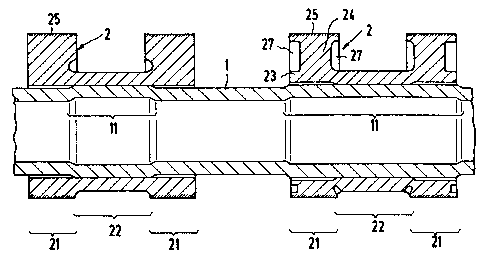Une partie des informations de ce site Web a été fournie par des sources externes. Le gouvernement du Canada n'assume aucune responsabilité concernant la précision, l'actualité ou la fiabilité des informations fournies par les sources externes. Les utilisateurs qui désirent employer cette information devraient consulter directement la source des informations. Le contenu fourni par les sources externes n'est pas assujetti aux exigences sur les langues officielles, la protection des renseignements personnels et l'accessibilité.
L'apparition de différences dans le texte et l'image des Revendications et de l'Abrégé dépend du moment auquel le document est publié. Les textes des Revendications et de l'Abrégé sont affichés :
| (12) Brevet: | (11) CA 1326962 |
|---|---|
| (21) Numéro de la demande: | 1326962 |
| (54) Titre français: | ARBRE DE COMMANDE AUQUEL SONT FIXES DES ORGANES D'ENTRAINEMENT GROUPES |
| (54) Titre anglais: | DRIVESHAFT WITH DRIVING ELEMENTS ATTACHED TO IT IN GROUPS |
| Statut: | Périmé et au-delà du délai pour l’annulation |
| (51) Classification internationale des brevets (CIB): |
|
|---|---|
| (72) Inventeurs : |
|
| (73) Titulaires : |
|
| (71) Demandeurs : |
|
| (74) Agent: | SMART & BIGGAR LP |
| (74) Co-agent: | |
| (45) Délivré: | 1994-02-15 |
| (22) Date de dépôt: | 1988-10-03 |
| Licence disponible: | S.O. |
| Cédé au domaine public: | S.O. |
| (25) Langue des documents déposés: | Anglais |
| Traité de coopération en matière de brevets (PCT): | Non |
|---|
| (30) Données de priorité de la demande: | ||||||
|---|---|---|---|---|---|---|
|
ABSTRACT
The force-locking connection between a shaft and
driving elements attached to it is improved or achieved
via a slight plastic expansion of the shaft in that the
driving elements are arranged in groups and connected by
connecting sleeves produced so as to be integral with the
driving elements. The higher degree of elastic expansion
is limited to the region of the connecting sleeves so that
the driving elements themselves are largely excluded from
this process. The dimensional accuracy of the finish-
machined driving elements is not adversely affected. If
necessary, recesses may be produced to form webs as a
result of which the elastic deformation occurring in the
inner region is reduced.
Note : Les revendications sont présentées dans la langue officielle dans laquelle elles ont été soumises.
Note : Les descriptions sont présentées dans la langue officielle dans laquelle elles ont été soumises.

2024-08-01 : Dans le cadre de la transition vers les Brevets de nouvelle génération (BNG), la base de données sur les brevets canadiens (BDBC) contient désormais un Historique d'événement plus détaillé, qui reproduit le Journal des événements de notre nouvelle solution interne.
Veuillez noter que les événements débutant par « Inactive : » se réfèrent à des événements qui ne sont plus utilisés dans notre nouvelle solution interne.
Pour une meilleure compréhension de l'état de la demande ou brevet qui figure sur cette page, la rubrique Mise en garde , et les descriptions de Brevet , Historique d'événement , Taxes périodiques et Historique des paiements devraient être consultées.
| Description | Date |
|---|---|
| Le délai pour l'annulation est expiré | 2010-02-15 |
| Lettre envoyée | 2009-02-16 |
| Inactive : CIB de MCD | 2006-03-11 |
| Inactive : CIB de MCD | 2006-03-11 |
| Inactive : TME en retard traitée | 2002-03-20 |
| Lettre envoyée | 2002-02-15 |
| Accordé par délivrance | 1994-02-15 |
Il n'y a pas d'historique d'abandonnement
| Type de taxes | Anniversaire | Échéance | Date payée |
|---|---|---|---|
| TM (catégorie 1, 4e anniv.) - générale | 1998-02-16 | 1998-01-23 | |
| TM (catégorie 1, 5e anniv.) - générale | 1999-02-15 | 1999-01-21 | |
| TM (catégorie 1, 6e anniv.) - générale | 2000-02-15 | 2000-01-14 | |
| TM (catégorie 1, 7e anniv.) - générale | 2001-02-15 | 2001-01-15 | |
| Annulation de la péremption réputée | 2002-02-15 | 2002-03-20 | |
| TM (catégorie 1, 8e anniv.) - générale | 2002-02-15 | 2002-03-20 | |
| TM (catégorie 1, 9e anniv.) - générale | 2003-02-17 | 2003-01-21 | |
| TM (catégorie 1, 10e anniv.) - générale | 2004-02-16 | 2004-01-19 | |
| TM (catégorie 1, 11e anniv.) - générale | 2005-02-15 | 2005-01-18 | |
| TM (catégorie 1, 12e anniv.) - générale | 2006-02-15 | 2006-01-24 | |
| TM (catégorie 1, 13e anniv.) - générale | 2007-02-15 | 2007-01-23 | |
| TM (catégorie 1, 14e anniv.) - générale | 2008-02-15 | 2008-01-23 |
Les titulaires actuels et antérieures au dossier sont affichés en ordre alphabétique.
| Titulaires actuels au dossier |
|---|
| EMITEC GESELLSCHAFT FUR EMISSIONSTECHNOLOGIE MBH |
| Titulaires antérieures au dossier |
|---|
| HELMUT SWARS |